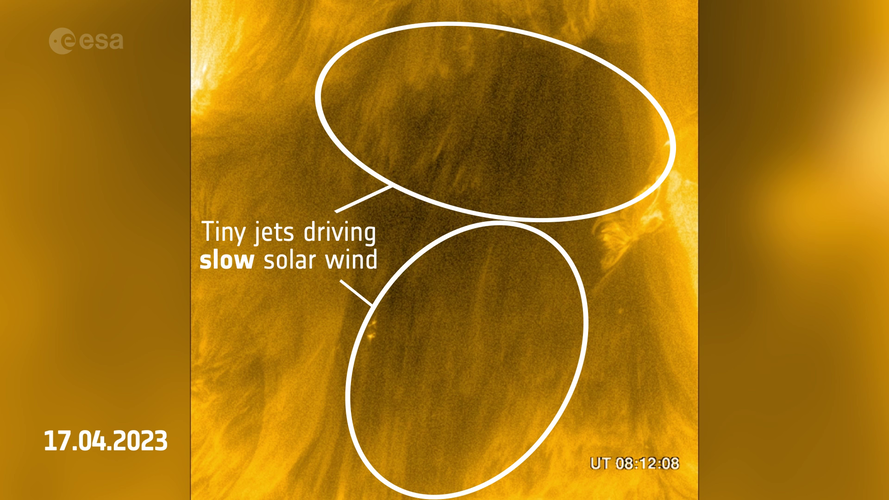Back in 2023, we reported on Solar Orbiter’s discovery of tiny jets near the Sun’s south pole that could be powering the solar wind. The team behind this research has now used even more data from the European Space Agency’s prolific solar mission to confirm that these jets exist all over dark patches in the Sun’s atmosphere, and that they really are a source of not only fast but also slow solar wind.
The newfound jets can be seen in this sped-up video as hair-like wisps that flash very briefly, for example within the circled regions of the Sun's surface. In reality they last around one minute and fling out charged particles at about 100 km/s.
The surprising result is published today in Astronomy & Astrophysics, highlighting how Solar Orbiter’s unique combination of instruments can unveil the mysteries of the star at the centre of our Solar System.
The solar wind is the never-ending rain of electrically charged particles given out by the Sun. It pervades the Solar System and its effects can be felt on Earth. Yet despite decades of study, its origin remained poorly understood. Until now.
The solar wind comes in two main forms: fast and slow. We have known for decades that the fast solar wind comes from the direction of dark patches in the Sun’s atmosphere called coronal holes – regions where the Sun’s magnetic field does not turn back down into the Sun but rather stretches deep into the Solar System.
Charged particles can flow along these ‘open’ magnetic field lines, heading away from the Sun, and creating the solar wind. But a big question remained: how do these particles get launched from the Sun in the first place?
Building upon their previous discovery, the research team (led by Lakshmi Pradeep Chitta at the Max Planck Institute for Solar System Research, Germany) used Solar Orbiter’s onboard ‘cameras’ to spot more tiny jets within coronal holes close to the Sun’s equator.
By combining these high-resolution images with direct measurements of solar wind particles and the Sun’s magnetic field around Solar Orbiter, the researchers could directly connect the solar wind measured at the spacecraft back to those exact same jets.
What’s more, the team was surprised to find not just fast solar wind coming from these jets, but also slow solar wind. This is the first time that we can say for sure that at least some of the slow solar wind also comes from tiny jets in coronal holes – until now, the origin of the solar wind had been elusive.
The fact that the same underlying process drives both fast and slow solar wind comes as a surprise. The discovery is only possible thanks to Solar Orbiter’s unique combination of advanced imaging systems, as well as its instruments that can directly detect particles and magnetic fields.
The measurements were taken when Solar Orbiter made close approaches to the Sun in October 2022 and April 2023. These close approaches happen roughly twice a year; during the next ones, the researchers hope to collect more data to better understand how these tiny jets ‘launch’ the solar wind.
Solar Orbiter is a space mission of international collaboration between ESA and NASA, operated by ESA. This research used data from Solar Orbiter’s Extreme Ultraviolet Imager (EUI), Polarimetric and Helioseismic Imager (PHI), Solar Wind Plasma Analyser (SWA) and Magnetometer (MAG). Find out more about the instruments Solar Orbiter is using to reveal more about the Sun.
Read more about how Solar Orbiter can trace the solar wind back to its source region on the Sun



 Video:
00:00:40
Video:
00:00:40